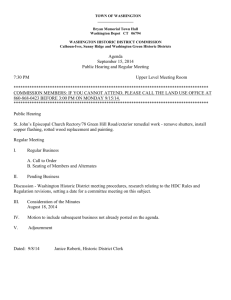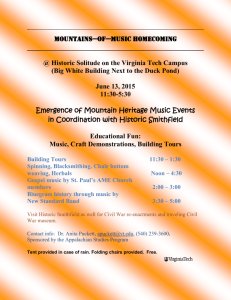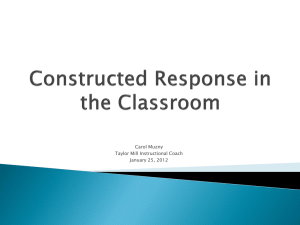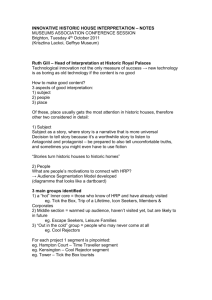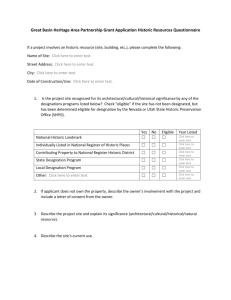School Renovation Successes
advertisement
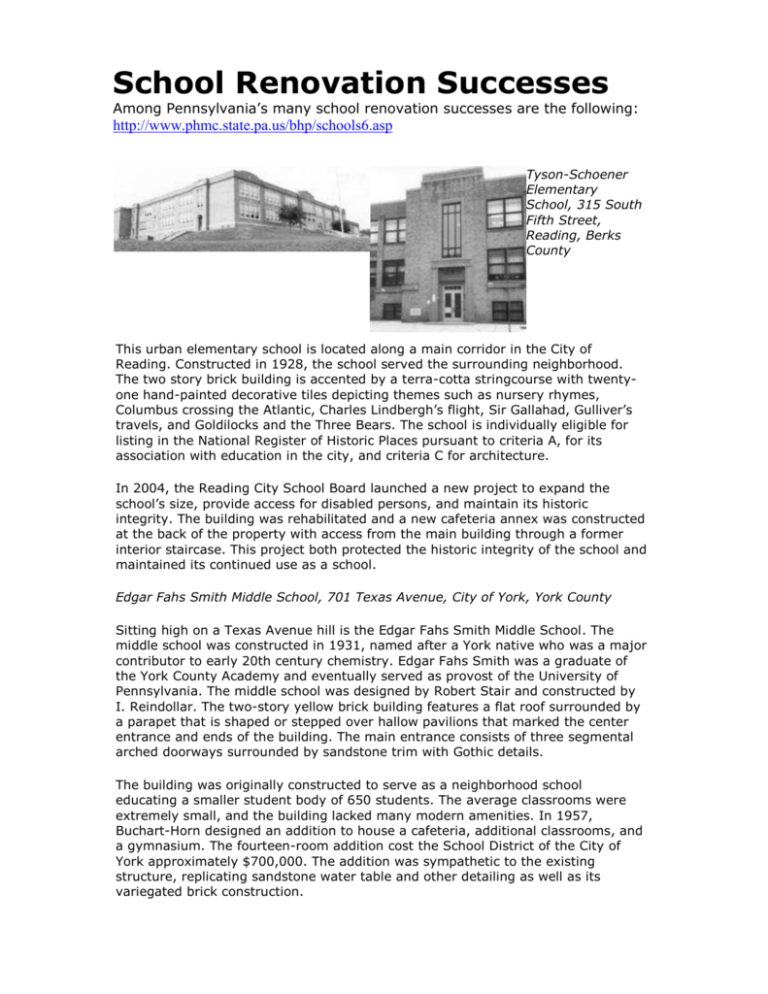
School Renovation Successes Among Pennsylvania’s many school renovation successes are the following: http://www.phmc.state.pa.us/bhp/schools6.asp Tyson-Schoener Elementary School, 315 South Fifth Street, Reading, Berks County This urban elementary school is located along a main corridor in the City of Reading. Constructed in 1928, the school served the surrounding neighborhood. The two story brick building is accented by a terra-cotta stringcourse with twentyone hand-painted decorative tiles depicting themes such as nursery rhymes, Columbus crossing the Atlantic, Charles Lindbergh’s flight, Sir Gallahad, Gulliver’s travels, and Goldilocks and the Three Bears. The school is individually eligible for listing in the National Register of Historic Places pursuant to criteria A, for its association with education in the city, and criteria C for architecture. In 2004, the Reading City School Board launched a new project to expand the school’s size, provide access for disabled persons, and maintain its historic integrity. The building was rehabilitated and a new cafeteria annex was constructed at the back of the property with access from the main building through a former interior staircase. This project both protected the historic integrity of the school and maintained its continued use as a school. Edgar Fahs Smith Middle School, 701 Texas Avenue, City of York, York County Sitting high on a Texas Avenue hill is the Edgar Fahs Smith Middle School. The middle school was constructed in 1931, named after a York native who was a major contributor to early 20th century chemistry. Edgar Fahs Smith was a graduate of the York County Academy and eventually served as provost of the University of Pennsylvania. The middle school was designed by Robert Stair and constructed by I. Reindollar. The two-story yellow brick building features a flat roof surrounded by a parapet that is shaped or stepped over hallow pavilions that marked the center entrance and ends of the building. The main entrance consists of three segmental arched doorways surrounded by sandstone trim with Gothic details. The building was originally constructed to serve as a neighborhood school educating a smaller student body of 650 students. The average classrooms were extremely small, and the building lacked many modern amenities. In 1957, Buchart-Horn designed an addition to house a cafeteria, additional classrooms, and a gymnasium. The fourteen-room addition cost the School District of the City of York approximately $700,000. The addition was sympathetic to the existing structure, replicating sandstone water table and other detailing as well as its variegated brick construction. By March 1995, the building’s growing pains were apparent. Faculty and staff created a list of needed improvements. The district decided that the existing building could be renovated to meet their requirements and hired Gilbert Architects to plan the rehabilitation. The renovation included a new library, large group instruction room, expanded athletic facilities, and administrative offices. Additionally, the building was made ADA compliant with the installation of ramps and an elevator. The building was enhanced for a more comfortable learning environment with the installation of air conditioning and larger classrooms with telephone and computer equipment. A rehabilitated cafeteria and auditorium were part of the new design, and the district purchased seven acres of land from the neighboring quarry to construct a surface parking lot to meet their needs. Mifflin School, 1290 Mifflin Road, Pittsburgh, Allegheny County The Mifflin School was constructed in 1932 by Link, Weber & Bower in the unique Art Moderne style. The building was enlarged in the 1950s with an L-shaped addition that enhanced elements of the original building and reflects characteristics of the Modern architectural movement. The school was designed to be located at the crest of a hill, which contributed to its impressiveness, overlooking the residential neighborhood it intended to serve. Its siting and design, however, created many accessibility issues for the building. As with any historic building, the Mifflin School was at a crossroads. The building required rehabilitation to address safety issues, enlarge the gymnasium and cafeteria space, improve air and traffic circulation throughout the building, as well as upgrading the building’s systems. In 2004, the school was expanded with a 17,000 square foot addition that included a new façade that functions as an accessible entry point from the main parking lot and school bus drop-off. Elevators were installed within both the new entry and existing buildings to facilitate accessibility throughout the complex. The rehabilitation and addition of the Mifflin School received a Pennsylvania Historic Preservation Award in 2005. Today Mifflin School continues to serve as a kindergarten through grade eight facility. The project’s architect, Strada, sensitively maintained the important historic and architectural characteristics of the historic school while making necessary improvements so that the historic school building can continue to educate future generations. William Shelly School, 1415 Stanton Street, West York Borough, York County The two William Shelly School buildings stand side by side at the intersection of North Adams and Stanton Streets in West York Borough, York County. The smaller of the two, now known as the Shelly Annex, was constructed c. 1897 as a oneroom schoolhouse. A rear addition was constructed and, eventually, a second floor was added around the turn-of-the-century. The larger Shelly School was constructed in 1905-08 and was rebuilt in 1919 after a devastating fire. It was designed in the Italian Renaissance style with two full floors on a raised basement. The Italian Renaissance style was frequently used for schools during the early twentieth century. Although the William Shelly School is not elaborately styled, it does have a number of notable stylistic features: its dark reddish-brown brick: rusticated brickwork around the basement level and on the facade, quoins, window and door lintels with keystones, corbel tables and belt courses. The school also has symmetrical fenestration, a hipped roof with prominent overhanging cornice, a large round-arched front entrance, two large round-arched windows and a Palladian-motif window. Although both buildings were originally constructed as elementary schools, the Shelly School was designed as a Junior-Senior High School in 1926. The Annex was used to house the Industrial Arts and Home Economic departments. After the West York Borough and West Manchester Township School Districts merged, a new senior high school building on Bannister Street was constructed in 1958. Both the Shelly School and its Annex were closed at that time and offered to the public for sale. The buildings were used as storage units while part of the first-floor of the Annex was used as an office. Little modernization or maintenance was done to the building while it sat vacant. Thus much of the original fabric was left intact. PFG Capital Corporation converted the buildings into housing in 1998, using both the Rehabilitation Investment and Low-Income Tax Credits. The building’s rehabilitation sympathetically preserved many of its Italian Renaissance-styled features: the wooden multi-light window sash and brownstone trim, the full-width hallways ending in double staircases with landings, turned balustrades and paneled newel posts; molded woodwork such as window frames, door architraves, baseboards and picture rail; tongue-and-lip joint wainscoting; paneled doors with large three-light transoms; a round-arched main entryway; and rounded plaster window jambs. Even some of the original blackboards were left intact. In all, seventeen apartments were created between the two buildings. Learn more about affordable housing through historic preservation by viewing the National Park Service’s case study on the William Shelly School at: http://www.cr.nps.gov/hps/tps/Affordable/CS3_Shelly_School.pdf Gallatin School, 165 North Gallatin Avenue, Uniontown, Fayette County The Gallatin School was constructed in 1908 in the Classical Revival style and designed by local architect Andrew B. Cooper. Its impressive façade is anchored by a two-story polychromatic terra cotta portico. A similar terra cotta cornice stretches across the facade and flanking side elevations. The school was located along a busy street just a few blocks from the center of town, just twenty-five miles southeast of Pittsburgh. The grandness of its architecture shows the importance of this small town’s dedication to provide the best opportunities to its youth. The school was enlarged in the 1940s to accommodate Uniontown’s growing population. In the early 1980’s, facing a declining urban population, the school system closed its existing elementary schools. The Gallatin School was sold in 1987 to a developer and converted into apartments. In all, the school was converted into 30 units of affordable housing. The building’s exterior was carefully cleaned and the terra cotta restored, windows were replaced, interior spaces—such as the central atrium and classroom corridors—were maintained while most of the interior classrooms were subdivided and designed for apartments. An original historic skylight was also reconstructed using archival photographs. When completed in 1998, the Gallatin School Apartments project restored the former grandeur of this architecturally-significant school and addressed an important housing need in the Uniontown community. Summit Hill High School, 124 West Hazard Street, Summit Hill Borough, Carbon County Constructed in 1911, Summit Hill High School was a significant feat of public architecture for this small working-class Pennsylvania coal town. The stylized NeoClassical Revival building has exceptional architectural detailing that suggests the importance of education to the community. Its design and architectural characteristics were intended to inspire learners. The building was constructed on an “I” floor plan with two narrow flanking wings. Classrooms were housed in the basement and first floor levels with a second floor auditorium complete with a proscenium arch. Constructed in response to the Pennsylvania Code of 1911—legislation that reorganized school districts across the Commonwealth—the Summit Hill High School replaced an earlier frame building from the 1870s. A district consolidation in the 1960s incorporated the Summit Hill Borough School District into the Panther Valley Joint School System and building was closed. After several subsequent owners and uses, the former school building was rehabilitated into 23 apartments in 1998 using federal Rehabilitation Investment Tax Credits. The project involved the careful rehabilitation of the exterior and preservation of original interior details. David Rittenhouse Junior High School, 1705 Locust Street, Norristown, Montgomery County The prominent Philadelphia architectural firm of Ritter and Shay designed the David Rittenhouse Junior High School, an outstanding example of the Colonial Revival style, in 1928. The building is constructed in red brick with carved limestone detailing similar to thousands of schools across the Commonwealth. The school is constructed in a typical “T” form. It was also expanded and updated several times in subsequent years, including the addition of a large 1950s-era gymnasium. The school district had planned for the building to be transformed into the Rittenhouse Alternative Vocational School in 1981, but for various reasons that did not occur. Rittenhouse remained a middle school until its closing in the early 1980s. The 56,272 square foot school building sat vacant for over 15 years until a federal Rehabilitation Investment Tax Credit project was proposed. Although there were many difficulties in planning the redevelopment of the school, one of the most problematic was providing adequate parking for the proposed 47 apartments in a densely settled neighborhood. Demolition of non-contributing gymnasium and cafeteria additions proved necessary to accommodate parking on-site without compromising any of the neighboring residential properties. Other associated work included retaining the double-loaded corridors and transforming classrooms into living space. Classroom doors were retained on the first floor to protect the character-defining appearance of the corridors. Two new elevators were installed as part of the building’s conversion into low-income elderly housing. School districts across the Commonwealth have also had success in rehabilitating other historic buildings for school uses. The School District of Lancaster in Lancaster County rehabilitated a former tobacco warehouse into the Carter and MacRae Elementary School. The school has an enrollment of 450 children in kindergarten through fifth grade. The Harrisburg School District partnered with Harrisburg University to renovate a former YWCA building in downtown Harrisburg into a 500 student-capacity high school called SciTech High. Learn more at: National Trust for Historic Preservation Historic Neighborhood Schools Success Stories http://www.nationaltrust.org/issues/schools/school_success_stories.html http://www.nationaltrust.org/issues/schools/downloads/NorthsideES_PA.pdf http://www.nationaltrust.org/issues/schools/downloads/PalmyraMS_PA.pdf

